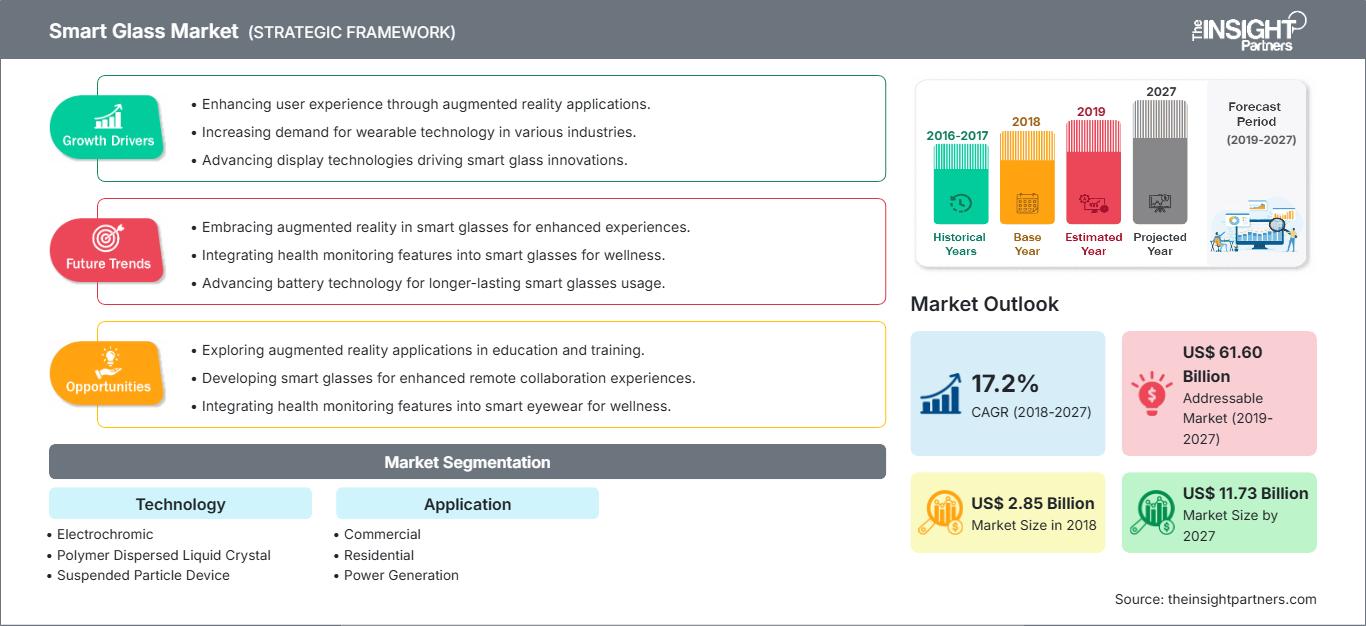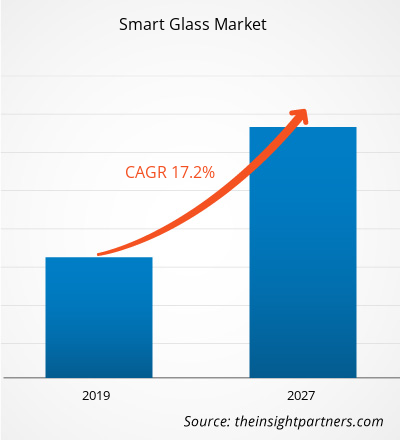[研究报告] 2018 年智能眼镜市场规模为 28.5 亿美元,预计到 2027 年将达到 117.3 亿美元;预计 2019 年至 2027 年期间的复合年增长率为 17.2%。
分析师观点:
智能眼镜市场近年来经历了显著的增长和技术进步,其中几个关键领域推动了这一发展。增强现实 (AR) 和虚拟现实 (VR) 智能眼镜获得了显著的发展,其应用范围已从娱乐和游戏扩展到汽车、数据分析和工业智能制造等领域。AR 智能眼镜由于能够将数字信息叠加到用户的现实环境中而越来越受欢迎。这项技术已在医疗保健、建筑和物流等各个行业得到实际应用,在这些行业中,免提访问关键数据和视觉引导至关重要。此外,增强现实和虚拟现实智能眼镜市场持续增长,制造商竞相提供更具沉浸感和直观体验的产品。可切换和电致变色玻璃技术在智能玻璃行业的转型中发挥了至关重要的作用。通过调整玻璃的色调或不透明度,这些创新解决方案在建筑应用中提高了隐私性、能源效率和用户舒适度。这些进步尤其影响了智能玻璃和智能窗户市场,吸引了寻求将智能玻璃技术融入建筑的商业和住宅领域的关注。此外,汽车智能玻璃市场也取得了显著发展,制造商将智能玻璃技术集成到车辆中。这种集成通过提供平视显示器 (HUD)、增强导航和实时信息来提升驾驶体验,所有这些都有助于提高驾驶员的安全性和便利性。主动式智能眼镜的需求也在增长,以满足那些寻求动态变化镜片或可调节视觉增强功能的用户的需求。这些眼镜具有光致变色镜片等功能,可根据各种光照条件和用户偏好提供自适应眼镜。在工业智能制造领域,智能眼镜彻底改变了工人与机器交互以及在工厂车间获取信息的方式。人工智能 (AI) 眼镜的集成实现了实时数据分析,在提高生产力和效率的同时减少了错误。随着智能眼镜市场的不断发展,越来越多的参与者进入智能眼镜行业,提供创新的解决方案和更强大的功能。顶级智能眼镜品牌致力于提供最佳的智能眼镜,融合尖端技术和无缝的用户体验。
市场概览:
智能玻璃是一种建筑玻璃,可以根据温度、电压或光线的变化改变其透光量。这些玻璃常用于住宅和商业建筑的内部隔断、窗户和天窗。智能眼镜可以实现手动和自动控制。智能玻璃的技术包括电致变色、光致变色、热致变色、悬浮颗粒、微百叶窗和聚合物分散液晶器件。智能玻璃与建筑围护结构集成后,可以构建适应气候的建筑外壳。智能窗户可能不需要百叶窗、遮阳帘和其他窗帘。除了控制自然光外,智能玻璃还可以限制紫外线和红外线,显示广告并提供安全保障。
自定义此报告以满足您的要求
您将免费获得任何报告的定制,包括本报告的部分内容,或国家级分析、Excel 数据包,以及为初创企业和大学提供超值优惠和折扣
智能玻璃市场: 战略洞察

- 获取本报告的主要市场趋势。这个免费样本将包括数据分析,从市场趋势到估计和预测。
市场驱动力:基础设施项目投资增长推动智能玻璃市场增长
您将免费获得任何报告的定制,包括本报告的部分内容,或国家级分析、Excel 数据包,以及为初创企业和大学提供超值优惠和折扣
智能玻璃市场: 战略洞察

- 获取本报告的主要市场趋势。这个免费样本将包括数据分析,从市场趋势到估计和预测。
基础设施项目投资增长已成为推动智能玻璃市场增长的关键驱动力。随着政府和私营部门加大对基础设施现代化和升级的投资,智能玻璃技术在各种项目中得到广泛应用,导致对这些创新解决方案的需求激增。智能眼镜正在产生重大影响的一个领域是建筑行业。增强现实 (AR) 智能眼镜在规划和施工阶段用于促进实时协作、可视化建筑设计并简化利益相关者的沟通。这些眼镜使现场工作人员无需实体蓝图即可访问重要信息,例如 3D 模型和说明,从而提高了生产效率并减少了错误。此外,将智能玻璃技术应用于智能建筑已成为一种突出趋势。可切换玻璃技术和电致变色玻璃正被集成到节能建筑中,优化自然采光并调节室内温度,从而降低能耗并提高居住舒适度。随着可持续建筑实践的兴起,智能玻璃和智能窗户市场正经历着大幅增长,这得益于对环保节能解决方案的需求。汽车智能玻璃市场也受益于基础设施投资的增加。随着各国政府致力于发展智慧城市和交通系统,智能眼镜已成为先进汽车不可或缺的一部分。增强现实 (AR) 抬头显示器 (HUD) 和配备可切换玻璃技术的智能窗户正被用于提升汽车安全性、导航性和互联互通性。此外,工业智能制造领域正在利用智能眼镜来提高基础设施项目的生产力和效率。佩戴智能眼镜的工人可以访问实时数据、接收指令并立即排除故障,从而减少停机时间并优化生产流程。随着基础设施项目融入智能制造实践,对主动式智能眼镜和人工智能驱动解决方案的需求预计将增长。基础设施项目投资的不断增长成为智能玻璃行业市场增长的催化剂。随着越来越多的项目集成智能玻璃技术以提高生产力、安全性和可持续性,对 AR 和 VR 智能眼镜、可切换玻璃和其他高科技玻璃解决方案的需求将持续增长。基础设施发展与智能玻璃应用的融合为制造商带来了丰厚的机遇,并推动了智能眼镜市场的创新。
细分分析:
根据技术,智能玻璃市场细分为:
- 电致变色
- 聚合物分散液晶 (PDLC)
- 悬浮颗粒装置 (SPD)
- 热致变色
- 光致变色
- 其他
悬浮颗粒装置 (SPD) 细分市场在 2018 年占据了最大的市场份额,预计在预测期内将实现最高的复合年增长率。悬浮颗粒装置 (SPD) 细分市场已成为主导者,在智能玻璃市场中占据最大份额。SPD 技术(也称为可切换玻璃技术)具有显著优势,例如可在透明和有色状态之间即时切换,从而实现对光透射和隐私的动态控制。这种多功能性在建筑和汽车应用领域引起了极大的兴趣。在建筑领域,SPD智能玻璃因其能够提高能源效率、调节室内温度以及营造互动性和视觉吸引力的环境而备受追捧。同样,在汽车行业,SPD智能玻璃也被集成到天窗、车窗和遮阳板中,为驾驶员和乘客提供可定制的遮阳选项、先进的眩光减少功能以及更高的舒适度。随着基础设施投资的增加,对智能玻璃技术的需求不断增长,SPD细分市场有望保持其领先地位,为整体市场增长做出重大贡献。
区域分析:
2018年,北美智能玻璃市场价值为10.4333万亿美元,预计到2027年将达到15.3861万亿美元;预计在预测期内,其复合年增长率将达到5.1%。北美智能玻璃市场已确立主导地位,呈现强劲增长态势,并占据行业最大份额。该地区市场领导地位的背后有几个关键因素。北美一直处于增强现实 (AR) 和虚拟现实 (VR) 技术发展的前沿,众多公司和初创公司在医疗保健、教育和娱乐领域率先推出智能眼镜的创新应用。这种早期应用为该地区 AR 和 VR 智能眼镜市场的增长奠定了坚实的基础。此外,北美的基础设施投资也刺激了对智能玻璃技术的需求,尤其是在建筑领域。可切换玻璃技术,例如悬浮颗粒装置 (SPD) 智能玻璃,因其节能和可持续的特性,在该地区广受欢迎。随着智能建筑和绿色环保倡议成为优先事项,北美市场对智能窗户和玻璃解决方案的需求激增,这些解决方案能够调节光线和温度,降低能耗,并提升乘客舒适度。受北美先进汽车工业和智能技术在汽车中的应用推动,汽车智能玻璃市场也蓬勃发展。在天窗、车窗和平视显示器 (HUD) 上采用智能眼镜(包括可切换玻璃解决方案)提升了驾驶体验,有助于提高道路安全性和便利性。此外,北美领先的智能玻璃技术公司和制造商在市场占据主导地位方面发挥了关键作用。这些公司在研发方面投入巨资,推动创新,并推出了尖端的智能玻璃产品。政府对智能基础设施项目和可持续建筑计划的支持进一步提振了北美智能玻璃市场。政策制定者已经认识到智能玻璃技术在能源效率、环境保护和改善城市生活方面的潜在优势,并因此出台了有利的法规和激励措施,从而刺激了市场增长。
关键参与者分析:
智能玻璃市场分析涵盖的参与者包括 AGC, INC.、ArtRatio SL、Compagnie de Saint-Gobain SA、康宁公司 (Corning Incorporated)、GENTEX Corporation、日立化成株式会社 (Hitachi Chemical Co., Ltd.)、Pleotint LLC、Polytronix, Inc.、Research Frontiers Incorporated 和 Smartglass International Limited。在智能玻璃参与者中,GENTEX Corporation 和康宁公司 (Corning Incorporated) 凭借其多样化的产品组合位居前两位。
智能玻璃市场区域洞察
The Insight Partners 的分析师已详尽阐述了预测期内影响智能玻璃市场的区域趋势和因素。本节还讨论了北美、欧洲、亚太地区、中东和非洲以及南美和中美洲的智能玻璃市场细分和地域分布。
智能玻璃市场报告范围
| 报告属性 | 细节 |
|---|---|
| 市场规模 2018 | US$ 2.85 Billion |
| 市场规模 2027 | US$ 11.73 Billion |
| 全球复合年增长率 (2018 - 2027) | 17.2% |
| 历史数据 | 2016-2017 |
| 预测期 | 2019-2027 |
| 涵盖的领域 |
By 技术
|
| 覆盖地区和国家 | 北美
|
| 市场领导者和主要公司简介 |
|
智能玻璃市场参与者密度:了解其对商业动态的影响
智能玻璃市场正在快速增长,这得益于终端用户需求的不断增长,而这些需求的驱动因素包括消费者偏好的不断变化、技术进步以及对产品优势的认知度不断提高。随着需求的增长,企业正在扩展产品线,不断创新以满足消费者需求,并抓住新兴趋势,从而进一步推动市场增长。

- 获取 智能玻璃市场 主要参与者概述
智能玻璃市场中的企业广泛采用并购等无机和有机战略。以下列出了一些近期的关键市场动态:
- 2022 年 2 月,Guardian Glass 推出了 ClimaGuard Neutral 1.0,该产品旨在满足英国建筑法规 L 部分关于新建和现有住宅窗户的规定。Guardian ClimaGuard Neutral 1.0 是一款用于双层玻璃窗的隔热镀膜玻璃,其 Ug 值为 1.0 W/m2K,与其他 U 值为 1.0 的住宅窗户玻璃产品相比,其色彩更中性,反射率更低,外观更美观。
- 2021 年 7 月,一站式建筑玻璃制造商 Viracon 推出了由 Halio 提供支持的 Viracon PLUS 智能玻璃,这是一款突破性的自变色智能玻璃解决方案,将 Halio, Inc. 专有的电致变色技术融入 Viracon 的绝缘玻璃单元中。由 Halio 提供支持的 Viracon PLUS 智能玻璃可自动调节色调水平,从而降低能耗,同时最大限度地利用自然光,从而优化居住者的舒适度。
- 历史分析(2 年)、基准年、预测(7 年)及复合年增长率
- PEST和SWOT分析
- 市场规模、价值/数量 - 全球、区域、国家
- 行业和竞争格局
- Excel 数据集
近期报告
相关报告
客户评价
购买理由
- 明智的决策
- 了解市场动态
- 竞争分析
- 客户洞察
- 市场预测
- 风险规避
- 战略规划
- 投资论证
- 识别新兴市场
- 优化营销策略
- 提升运营效率
- 顺应监管趋势




















 获取免费样品 - 智能玻璃市场
获取免费样品 - 智能玻璃市场